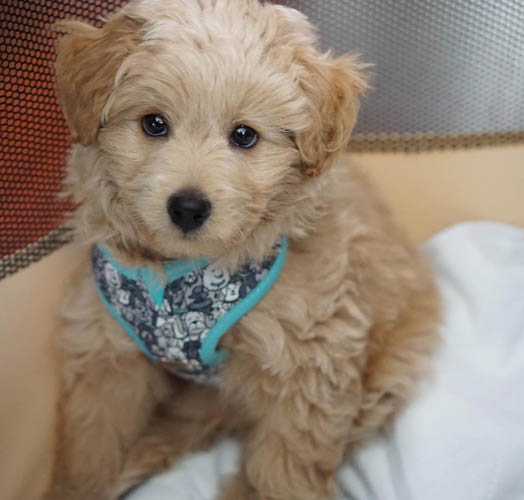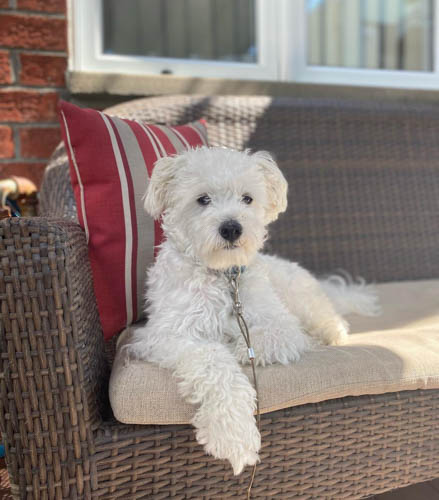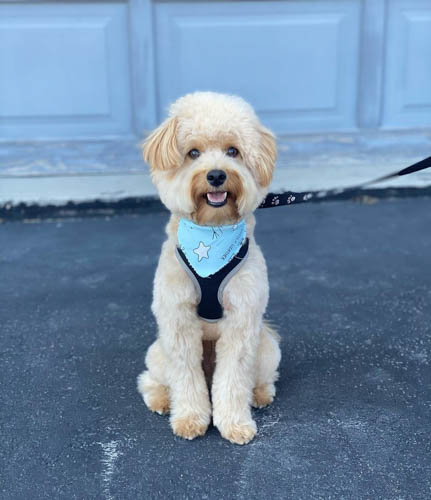Some dogs are being bred because of their special qualities such as intelligence, speed, or agility. Others are specially chosen for their beautiful looks or coat quality.
Hybrid dog breeding has become common because it allows breeders to create a new breed with the best qualities of two dog breeds.
The Eskipoo is one of the many great examples of a hybrid dog. This hybrid may not be that famous, but its potential is great due to its inherited positive traits from both parents.
Whether you’re looking for a dog companion to spend your days being a retiree or would love to give your family their first dog, having an Eskipoo is an excellent choice.
These highly active dogs, also known as the Eksapoo or Pookimo, naturally have a happy disposition and love to spend much time with their family.
What’s an Eskipoo dog?

The Eskipoo dog breed is a cross between the American Eskimo and Poodle. These dogs are small in size, with round eyes that are mostly blue, with a short black muzzle, floppy ears, and a dense coat. Due to its happy temperament and good nature, it has been a popular pet choice for all ages.
The Eskipoo is believed to have come into existence in the late 20th century. However, little is known as who first bred the Eskipoo and when. Some believed it could first be traced back to Egyptian and Roman times, while some researchers believe they originally came from Germany.
What does an Eskipoo look like?
An Eskipoo is a small-sized dog with a round head. It has a floppy and large triangular poodle-style ears and a black nose. Its eyes can either be brown or blue.
If you’re considering making Eskipoo your pet, you can be given two options. First, you can get an Eskipoo with a short and smooth curly coat like a Poodle. Second, you can have an Eskipoo with a long and thick coat like an American Eskimo.
Most of the time, their coat is medium-length and could either be quite dense or way with a double layer. Since they often have a dense coat, this breed is more suitable for colder environments.
The Eskipoo is also available in many coat colors. Below is the rundown of their available colors.
- White: This is the most common color available for an Eskipoo.
- Apricot: They’re also available in an apricot color and can come in dull to saturated orange.
- Black: You can also see Eskipoos with black-colored coats. Some have pure black color, while some can have tints of blue or red.
- Brown: They also come in a variety of shades of brown that range from light to dark brown.
- Cream: They also come in light-off white or deep tan color of cream.
- Grey: Some Eskipoos have grey coats, or sometimes their coat changes to grey color before they turn five years of age.
What is the Eskipoo temperament?

When you make an Eskipoo your pet, you can expect it to be affectionate, playful, energetic, and gentle. Because of their friendly and cheerful personality, they can be a great addition to your family.
Their size makes them ideal for apartment, house, or condo living as long as they have adequate time to get sunshine and fresh air and go for an exercise outside.
It’s even better if you have a fenced backyard, but you need to walk them daily and give them indoor playtime like tug of war or play catch for those who don’t.
Additionally, their jolly and loving disposition makes them suitable for all ages, including elders and children. They’re also full of affection and loyalty, making anyone in the family feel so loved.
But always remember to supervise them if you let them play with children, especially the toddlers. Moreover, if you have other dogs in the household, the Eskipoo can easily get along with them, as long as you keep them socialized with each other.
This breed needs a lot of your attention and love to keep its disposition up. There is a downside, though, in their clingy nature. If you don’t give them attention for a long time, they can easily develop separation anxiety.
As a result, they can get bored and start chewing on your house furniture or bark excessively. Hence, if you’re someone who spends most of your time outside the home or if there’s no one in the house to look after it, then this breed may not be right for you because of their tendencies.
This breed also tends to bark or howl at unfamiliar sights, faces, or sounds. But this can be resolved with proper training.
Senior citizens or retirees who love a gentle yet fun-loving pooch and challenge themselves with moderate activity during the day can greatly benefit from the Eskipoo dog.
Is an Eskipoo a good family dog?

The Eskipoo is an incredible companion dog who will give you love, loyalty, and affection, making them a good family dog. Their playful nature makes them a joy to be around. They also do well with children. They like to lick your child in their little fingers and head and cuddle them.
This breed has a very loyal temperament; hence, if you’re gone even for a couple of hours, they’ll have difficulty adjusting. They’re high-energy dogs, so you need to ensure they get plenty of daily playtimes.
How big does Eskipoo get?
Eskipoos can grow up to 9 and 16 inches (22.9 and 40.7 centimeters) tall.
How much does Eskipoo weigh?
They can weigh between 10 and 20 pounds (4.5 and 9 kilograms).
Does Eskipoo shed?
Eskipoos are low maintenance, which means shedding light and drooling isn’t much of a problem.
Depending on their inherited traits from their parents, they can be curly and single-layered like the Poodle or fluffy and thick-layered like the American Eskimo. Sometimes, their coat is in between. Like most Poodle mixed breeds, Eskipoos usually inherit the hypoallergenic and low-shedding coat, which means they don’t normally shed a lot. Even so, to avoid tangling or matting their coats, you need to brush them frequently using a slicker brush.
Moreover, Eskipoos rarely drools. But if they do excessive drooling, it may be a sign of a problem that needs medical attention from a veterinarian.
How often should you bathe an Eskipoo?

According to Beth Cristiano, the owner of Pretty Paws LLC, the frequency your pet needs a bath will depend upon their lifestyle, coat length, breed, and lastly, how much work you’re willing to do as their pet owner.
In the case of Eskipoos, they don’t shed a lot, which means they don’t need to be bathed often. Once every 2 to 3 months is adequate; however, they often need brushing to keep their coats in good shape. The recommended brushing is between 4 to 5 times per week.
The rule of thumb is to wash your dogs when they’re no longer huggable.
What are the grooming requirements of an Eskipoo?
As mentioned earlier, this breed is low maintenance. To take care of its coat, you need to brush it at least 4 to 5 times per week. The recommended brush to use is a soft brush and a wide-tooth comb.
Again, bathing is only required once every 2 to 3 months. Only bathe them if dirt is visible in their coat. The reason for not bathing them all the time is to preserve any natural oil from being washed out, which keeps its coat naturally shiny.
If it takes after its Poodle parent, you also need to bring it to a professional groomer every 2 to 3 months for a haircut.
In terms of brushing their teeth, you should do it daily. Their nails, however, should be trimmed every two weeks. You should also regularly check their ears and eyes and remove any dirt around them to reduce any risks of infection.
Does an Eskipoo bark a lot?

Eskipoos are social dogs who love to be in the company of humans. They hate to be left alone and can become destructive to your belongings or bark excessively when this happens.
They also bark a lot when they see unfamiliar faces, hear unusual sounds, or experience a different environment. But with proper training over time, this behavior can be changed or minimized. For this reason, it’s recommended to place them in training programs to minimize this behavior.
Are Eskipoo hypoallergenic?
Since Eskipoos have coats, you’re probably curious if they are hypoallergenic. If you suffer from an allergy, you’re in luck since Eskipoos are hypoallergenic. But, this is only true if they inherited the genes of their Poodle parent.
Since Eskipoos are cross-breed, there’s a tendency that they inherit their coat from their American Eskimo parent. If this is the case, prepare for some shedding. The shedding is most especially experienced in-between seasons. Having an American Eskimo dominant gene will give them a thicker coat and more hair to shed.
To be safe, ask the breeder first about the Eskipoo’s family history. If you have allergies, make sure you get the one whose genes are more dominant to its Poodle parent. Similarly, you can try to adopt it for a few days and see if your allergies respond to it.
What is the food/diet of an Eskipoo?

Since Eskipoo is a high-energy dog, they will require a healthy diet of excellent quality kibble. This breed is prone to having dental issues, so giving them dry kibble is strongly recommended to keep their teeth strong and healthy. You can also give them wet food if their dental issues make it impossible for them to chew dry kibble.
Eskipoo behavior problems
Generally, Eskipoos are great and lovely dogs to have when trained well. However, there are potential issues in their behavior when their training goes awry. Below are some of the most common behavioral problems in Eskipoos.
- Too much barking
There is a potential behavioral problem with an Eskipoo barking a lot. This means their potential as apartment dogs can be limited. They have an innate ability to bark at the signs of trouble. Hence, they’re easily set off with unusual sounds or unfamiliar scenarios.
- Suffer from separation anxiety
Eskipoos need attention most of the time. If left alone for a long period, they have the tendency to be depressed and have separation anxiety. This leads to them being destructive to your belongings.
- Stubborn
Another thing you need to know about Eskipoos is their stubbornness. This breed wants to get things their way.
- Too Energetic
This breed has so much energy, which means they need a lot of daily exercise and playtime. This means that you need to be ready to invest lots of time, affection, and energy to make them feel loved and maintain their well-being.
Is Eskipoo easy to train?

The potential issues stated above of the Eskipoos mean that owners may need to seek professional help, especially when these behavioral problems start to manifest. Training is important at an early age, especially in the areas of separation training and socialization.
Eskipoos are people pleasers, which makes them easy to train. But they need a trainer who can teach them with patience and consistency.
They respond very well to positive reinforcements. Hence, in training them, you should provide them with treats such as food and even vocal praises to reward them if they do a great job.
These dogs are also pretty intelligent, adding to the ease it takes to train them. Since they’re very active and need mental stimulation, you may need to give them more time and attention.
Their parents are both working dogs, which means they thrive when given a job to do. And often, they do a good job to please their owners.
What is the average lifespan of Eskipoos?
Eskipoos, on average, can live up to 10 to 13 years. This is if they’re looked after and fed very well.
What are the common health problems of Eskipoos?

The average lifespan of an Eskipoo can be reduced, however, if they suffer from health problems. The following are the most common health problems of Eskipoos.
- Luxating Patellas
A luxating patella is a condition in which a dog’s kneecap shifts out of alignment. This condition is a common occurrence among dogs, but smaller breeds are more affected. This condition can be treated with medication and physical therapy. But, in severe cases where your dog feels significant pain, surgery may be necessary.
- Cataracts
As your Eskipoo age, it may develop cataracts as humans do. A cataract is a cloudy film that sets into your dog’s eye lens, preventing light from entering. Cataracts form when the protein from your dog’s eyes clump together and begin forming a cloud-like substance in the eyes’ lens. Unfortunately, no pill or eye drop can reverse the damage in the lens. Only surgery can remove the cloudy lens in your dog’s eyes and restore its sight.
- Squamous cell carcinoma
Squamous cell carcinoma is developed due to the lesions of the nail bed or toe of the dog. When the lesions get irritated, it may lead to some serious condition known as Squamous cell carcinoma. Only surgery can heal this condition. Studies found that 95% of dogs who had surgery from this condition can survive for at least a year after surgery.
- Epilepsy
Epilepsy is a neurological disorder in dogs. Seizures often happen when the brain changes its activity, such as when the dog gets too excited for feeding or as they wake up or fall asleep.
- Gastric dilation volvulus
Gastric dilatation-volvulus, also known as the twisted stomach, is a condition wherein the dog’s stomach becomes overstretched or rotated due to excessive gas content. Exercise after eating increases its risk. And since Eskipoos are known to be hyperactive, they tend to develop this medical condition.
How much does an Eskipoo cost?

The cost of Eskipoos will always vary on several factors such as their breeder, the location, and of course, the supply and demand.
If you live in a place where Eskipoos are popular but with only a few breeders, the price for each pup may increase, especially if you want a healthy and quality dog.
Some breeders also charge more if an Eskipoo has rare characteristics such as having blue eyes or colors of apricots and browns.
The median cost of an Eskipoo puppy is $600, while the top quality puppies cost between $1,700 and $5,300.
Before you buy or adopt a puppy, it’s important to know the costs associated with becoming a dog owner.
When you calculate your budget, ensure you account for the prices of food, deworming, heartworm, vaccines, vet bills, flea control, grooming, spay/neuter fees, dental care, training, and other supplies such as a leash, collar, crate, bowls, bed, bones, and toys.
Each of these items can add up quickly, so ensure you allot a budget between $500 and $2000 for the first year and $500 and $1000 in the next years.
Where to buy or adopt an Eskipoo dog?

If you want to be an Eskipoo owner, you can buy from reputable and trustworthy breeders. However, if you opt to find Eskipoos in rescue centers, your chances of getting them are high.
This is because many of these owners don’t realize how much energy and time they need to take care of this cross-breed.
Eskipoos’ constant need for affection, entertainment, and play may be too much for some owners, especially when the dogs become disruptive and depressed when left alone. Hence, they tend to abandon them and leave them in a rescue shelter.
If you want to find an Eskipoo pup in a rescue shelter, you need to understand their personality and needs and think long if you have the commitment and ability to meet their needs.
If you want to be an Eskipoo owner, the best places are the following websites.
- https://www.petfinder.com/pet-adoption/dog-adoption/
- https://www.adoptapet.com/dog-adoption
- https://www.petrescue.com.au/
- https://marketplace.akc.org/search-puppies
What have we learned about the Eskipoo?
Eskipoos have their advantages and disadvantages.
One advantage of being an owner of this breed is that they’re easy to maintain. Their coats can be managed just by brushing, and when you have the poodle gene breed, their coat is hypoallergenic. This means even if you are sensitive to allergens, their coat won’t affect you.
However, don’t also overlook their potential behavioral problems, which can be a challenge for you later on.
First, they’re not suitable as apartment dogs as they need more space to exert their high energy. But, if you can commit to taking them for walks and bringing them to parks or a big yard where they can play, then it wouldn’t be a problem.
Second, they struggle with being left alone. When you don’t give them much time and attention, they will develop separation anxiety. But, if you have people at home all the time to tend to them, they may well adjust even if you’re away for some time.
With this, you need to further research this breed to have a more informed decision.
Is the Eskipoo right for you?
If you’re considering becoming an Eskipoo owner, you need to have a high level of commitment towards these dogs.
Since you already know their traits, potential behavioral problems, and needs, you must be ready to provide them with enough love, time, affection, and attention. You also need to be prepared to give them their much-needed playtime.
When you can commit to these, you will enjoy many years with these loving and affectionate creatures. They are very good family dogs with the right level of attention and proper training.